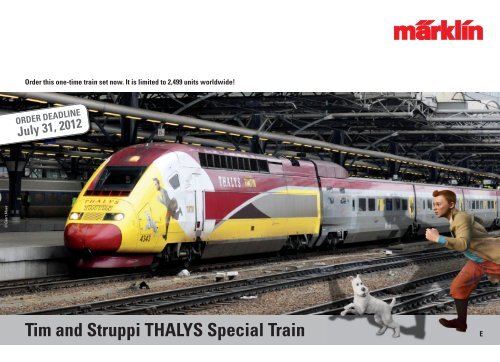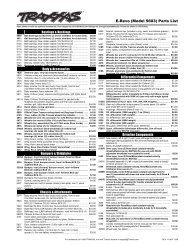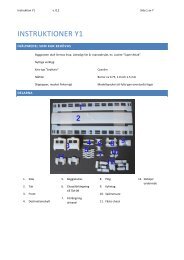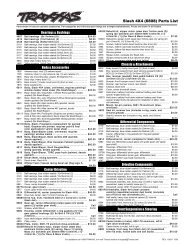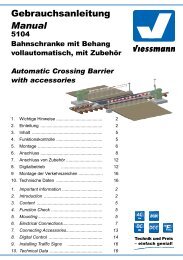Märklin Thalys "Tintin" - ToToTrains
Märklin Thalys "Tintin" - ToToTrains
Märklin Thalys "Tintin" - ToToTrains
- No tags were found...
You also want an ePaper? Increase the reach of your titles
YUMPU automatically turns print PDFs into web optimized ePapers that Google loves.
Order this one-time train set now. It is limited to 2,499 units worldwide!<br />
ORDER DEADLINE<br />
July 31, 2012<br />
© Geert Maes<br />
Tim and Struppi THALYS Special Train<br />
E
<strong>Thalys</strong>, Tim and Struppi, Schulze, and Schultze, Captain Haddock...<br />
The comics about the ageless reporter and detective Tim<br />
as well as his white fox terrier Struppi (in the original<br />
“Tintin & Milou”) belong to the classics of children’s<br />
literature. In 1929 the Belgian Georges Remi (1907 to<br />
1983) published the first episode under his writing name<br />
“Hergé”. The name “Hergé” came by the way from the<br />
French pronunciation of his initials (reversed). The 24 original<br />
stories have sold about 230 million copies since the<br />
first story appeared and have been translated into over 80<br />
languages. Hergé’s characters such as Professor Bienlein,<br />
Schulze and Schultze, Cap’n Haddock, the opera singer<br />
Bianca Castafiore, and many others populated almost every<br />
child’s bedroom in the second half of the 20th century.<br />
© 2011 Paramount Pictures and Columbia Pictures <strong>Thalys</strong>. All Rights Reserved<br />
In 1999 the title “The Blue Lotus” placed eighteenth among<br />
the most important books in the 20th century according<br />
to a survey by the French newspaper “Le Monde”. “Tim<br />
and Struppi” were in good company with Aldous Huxley,<br />
Alexander Solzhenitsyn, and Anne Frank. The secret of his<br />
success was no doubt Hergé’s clear way of drawing<br />
and telling a story.<br />
Director Steven Spielberg and producer Peter Jackson,<br />
two visionary story tellers of their time and both Oscar<br />
winners, took up the filming of the famous comics of Hergé<br />
in 2009. Spielberg had already secured the rights to the<br />
“Tim and Struppi” stories 30 years ago. Their computeranimated<br />
film combines the three adventures “The Crab<br />
with the Golden Scissors”, “The Secret of the Unicorn”,<br />
and “The Treasure of Rackham the Red” into a new story.<br />
The characters correspond exactly to the originals with all<br />
of their quirks, their angles, and edges. For example, Captain<br />
Haddock swears constantly and is a heavy drinker –<br />
but is always there for Tim in spite of this and bucks him<br />
up when he needs it.<br />
© 2011 Paramount Pictures and Columbia Pictures <strong>Thalys</strong>. All Rights Reserved<br />
© 2011 Paramount Pictures and Columbia Pictures <strong>Thalys</strong>. All Rights Reserved
© Geert Maes<br />
© Geert Maes<br />
© Geert Maes<br />
The international railroad company <strong>Thalys</strong> International in<br />
Brussels is a subsidiary of the French (SNCF) and Belgian<br />
State Railways (NMBS/SNCB). Additional partners are<br />
the subsidiary of the Dutch State Railways <strong>Thalys</strong> Nederland<br />
and the German Railroad. The participating railroad<br />
companies SNCF, SNCB, DB, and NS agreed in June of<br />
1992 on a common train for high-speed service between<br />
Paris, Brussels, Cologne, and Amsterdam (PBKA). These<br />
four-current PBKA high-speed trains with their characteristic<br />
paint scheme in Bordeaux red and gray metallic<br />
are a further development of the TGV, are marketed under<br />
the product name “THALYS”, and are operated by <strong>Thalys</strong><br />
International.<br />
With its headquarters in Brussels it absolutely made sense<br />
for <strong>Thalys</strong> International to be the official partner of Steven<br />
Spielberg’s new film and <strong>Thalys</strong> International staged a<br />
spectacular advertising stunt for the premiere of the film<br />
“The Adventure of Tim and Struppi – The Secret of the<br />
Unicorn”:<br />
The premiere celebrations for the Spielberg film took place<br />
on October 22, 2011 in Brussels and Paris. This film was<br />
awaited with excitement and the world premiere started in<br />
Brussels. Just a few hours later the second presentation<br />
began in Paris. This allowed a <strong>Thalys</strong> PBKA to connect<br />
both metropolitan areas at high speed. On that day the<br />
travel time of 1 hour 22 minutes was done however in a<br />
special “Tim and Struppi” <strong>Thalys</strong>.<br />
This <strong>Thalys</strong> with road number 4343 was in a completely<br />
“Tim and Struppi” design. Several characters from Hergé’s<br />
famous comics were applied to the train with adhesive<br />
sheets; these characters were given new life in Steven<br />
Spielberg’s 3D film. Tim and Struppi were on the train again<br />
just like Schulze and Schultze and naturally also Captain<br />
Haddock. This train was presented for the first time to the<br />
public on October 22 and transported the world famous<br />
director and his entire team after the Brussels premiere,<br />
among them the actors Jamie Bell and the producer Kathleen<br />
Kennedy. Numerous photographers and fans were<br />
waiting at the Paris Gare du Nord station for the train with<br />
Steven Spielberg and his film team. They all applauded<br />
this famous director when he signed a <strong>Thalys</strong> powered<br />
end car.
About the THALYS PBKA<br />
Initially, 17 <strong>Thalys</strong> train sets were ordered from GEC-Alsthom<br />
by the four participating railroads SNCF, SNCB, DB,<br />
and NS. Of them the SNCB took seven units (4301-4307),<br />
the SNCF six (4341-4346), the NS two (4331-4332), and the<br />
DB two (4321-4322), which the DB internally designates<br />
as the class 409. The <strong>Thalys</strong> PBKA has been in operation<br />
since December 14, 1997 from Paris to Brussels and then<br />
further on to Amsterdam or Cologne.<br />
With its rounded nose the <strong>Thalys</strong> PBKA externally resembles<br />
the TGV Duplex; from a technical point of view it is<br />
related to the TGV Réseau, the third generation TGV. The<br />
<strong>Thalys</strong> PBKA was 50% more expensive to purchase than<br />
the TGV Réseau, because it has to be able to handle four<br />
different electrical current systems and seven different<br />
signal systems, which its onboard computer automatically<br />
recognizes. The <strong>Thalys</strong> is designed for left or for right<br />
hand operation. The engineer’s controls were therefore<br />
arranged in the middle of the cab. The power output and<br />
the operating speed depend on the electrical current system.<br />
The continuous power output of the trains at 1.5<br />
kilovolts DC (the customary Dutch network) and at<br />
15 kilovolts/16 2 / 3 Hertz AC (German network) is only<br />
3,680 kilowatts / 4,933 horsepower. At 3 kilovolts DC<br />
(the customary Belgian network) it is at least 5,210 kilowatts<br />
/ 6,984 horsepower. All of this is only enough for<br />
a maximum speed of 220 km/h / 138 mph. The <strong>Thalys</strong><br />
reaches its permissible 300 km/h / 188 mph only with 25<br />
kilovolts/50 Hertz (parts of the French, Belgian, and Dutch<br />
high speed routes) with a power output of 8,800 kilowatts /<br />
11,796 horsepower.<br />
A train set consists of two powered end cars and eight intermediate<br />
cars. The intermediate cars are connected to<br />
each other by means of Jakobs trucks and thereby form<br />
an operating unit. Five intermediate cars (one with a bar)<br />
are for passengers in 2nd class and three intermediate<br />
cars are for 1st class. The about 200 meter / 650 foot <strong>Thalys</strong><br />
has seating for a total of 377 passengers. These cars<br />
have been freshened up intensively in recent years with<br />
the following innovations: new interiors and a new look<br />
in flaming red and silver – borrowing from the previous<br />
<strong>Thalys</strong> colors but with new graphic elements. The trains<br />
are serviced in Brussels; for that reason the DB train sets<br />
have not been given DB numbers. They are currently run<br />
in Germany on approximately two hour cycles between<br />
Paris and Cologne and with one pair of trains even going<br />
on to Essen.<br />
Ostende<br />
PARIS<br />
Bruges<br />
Gent<br />
Mons<br />
Rotterdam<br />
Antwerp<br />
AMSTERDAM<br />
Schiphol<br />
BRUSSELS<br />
Aachen<br />
Liège<br />
Namur<br />
Charleroi<br />
Essen<br />
COLOGNE
...onboard a unique special train.<br />
$/cehN+j8|<br />
37795 High Speed Train.<br />
Prototype: High speed train painted and lettered for<br />
the THALYS PBKA of <strong>Thalys</strong> International, Brussels,<br />
Belgium in the multi-system version for service<br />
between Paris, Brussels, Cologne, and Amsterdam.<br />
2 powered end cars (TK1 and TK2), 1 transition<br />
car (R1), 1st class, 1 transition car (R8), 2nd class.<br />
2 transition cars (R2 und R3), 1st class, 1 bar car<br />
(R4), 2nd class, 3 intermediate cars (R5, R6, R7), 2nd<br />
class. Special version for the premiere of the film<br />
“The Adventures of Tim and Struppi – The Secret of<br />
the Unicorn”. The train looks as it did for the special<br />
run on October 22, 2011 from Brussels to Paris.<br />
Model: This is a complete 10 part train. Both end<br />
cars (TK1 and TK2) are powered. The train has an<br />
mfx digital decoder and extensive sound functions.<br />
It has controlled, high-efficiency propulsion in<br />
both powered end cars, centrally mounted. 4 axles<br />
powered through cardan shafts in each end car.<br />
Traction tires. The transition and intermediate cars<br />
have factory-installed interior lighting. The triple<br />
headlights and dual red marker lights change over<br />
with the direction of travel. They and the interior<br />
lighting will work in conventional operation and can<br />
be controlled digitally. The third headlight for the<br />
French headlight code can be turned off separately<br />
in digital operation. The headlights and interior lighting<br />
are maintenance-free, warm white LEDs and the<br />
marker lights are maintenance-free red LEDs. The<br />
powered end cars have separately applied metal<br />
grab irons and inset windshield wipers. The engineer’s<br />
cabs in the powered end cars have interior<br />
details. The powered end cars and transition cars<br />
as well as the intermediate cars are permanently<br />
coupled together in pairs and have special close<br />
couplings with a guide mechanism. There is an additional<br />
guide mechanism in the Jakobs truck. The end<br />
cars have a pickup shoe changeover feature so that<br />
the pickup shoe at the front of the train is the one<br />
picking up power. The interior lighting is powered<br />
through a continuous electrical connection through<br />
the entire train. Each powered end car has 2 SNCF<br />
design single-arm pantographs. The pantographs<br />
work mechanically but are not wired to take power.<br />
The train is a scale reproduction. The minimum<br />
radius for operation is therefore 360 mm / 14-3/16”,<br />
when there is sufficient clearance on both sides.<br />
Length of the 10-part set 230 cm / 90-9/16”.<br />
The complete train comes in exclusive special<br />
packaging. A consecutively numbered certificate<br />
of authenticity is included.<br />
One-time series.<br />
**<br />
• Extremely limited edition,<br />
2,499 pieces.<br />
• Consecutively numbered<br />
certificate of authenticity included.<br />
• Exclusive special packaging.<br />
• A scale reproduction in 1:87.<br />
• Both end cars powered.<br />
• Extensive sound functions.<br />
• Factory-installed interior lighting<br />
in the transition and intermediate<br />
cars.<br />
Order deadline July 31, 2012.<br />
Delivery planned for 1st quarter of 2013.<br />
Digital Functions<br />
Control<br />
Unit<br />
Mobile<br />
Station<br />
Mobile<br />
Station 2<br />
Central<br />
Station<br />
Headlight(s) x x x x<br />
Interior lights x x x x<br />
Light Function 1 x x x x<br />
Electric locomotive op. sounds x x x x<br />
Horn x x x x<br />
Direct control x x x x<br />
Sound of squealing brakes off x x x<br />
Doors Closing x x x<br />
Whistle for switching maneuver x x x<br />
Conductor‘s Whistle x x x<br />
Stat. Announce. - Fren. x x<br />
Station Announcements x x<br />
Station Announcements x x<br />
Stat. Announce. - Engl. x x<br />
© Dennis Koster<br />
© Stichting Railpublicaties
Gebr. <strong>Märklin</strong> & Cie. GmbH<br />
Stuttgarter Straße 55 - 57<br />
73033 Göppingen<br />
Deutschland<br />
www.maerklin.com<br />
We reserve the right to make changes<br />
and delivery is not guaranteed.<br />
Pricing, data, and measurements may<br />
vary. We are not liable for mistakes and<br />
printing errors.<br />
Some of the models shown in the<br />
photographs are hand samples.<br />
The regular production models may<br />
vary in details from the models shown.<br />
* All prices are suggested retail<br />
prices. If these edition of the presentation<br />
book does not have prices,<br />
please ask your authorized dealers<br />
for the current price list.<br />
** Age Information and Warnings:<br />
For adults only.<br />
All rights reserved.<br />
Copying in whole or part prohibited.<br />
Printed in Germany.<br />
190260 – 06 2012<br />
© Copyright by<br />
Gebr. <strong>Märklin</strong> & Cie. GmbH<br />
© Stichting Railpublicaties<br />
An explanation of the symbols can be<br />
found in the current <strong>Märklin</strong> catalog.


